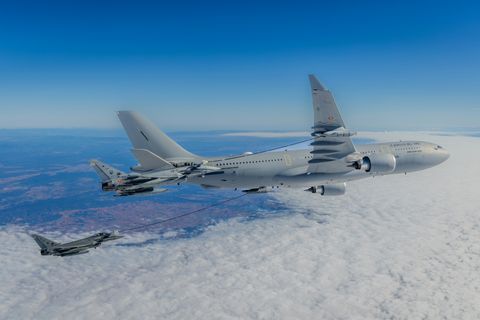#EurofighterNextGen - Taking the Eurofighter to the next level

Always on duty for security and freedom - 30 years after its maiden flight, the Eurofighter is more important than ever. Here are 30 facts and figures on why the European fighter jet will continue to be state-of-the-art for the next three decades:
Experience of a lifetime
On March 27, 1994, the Eurofighter Typhoon DA1 (Development Aircraft) took off for its maiden flight in Manching, Bavaria. A unique experience for test pilot Peter Weger: "I knew that I was piloting an incredible aircraft and that we had something special. It was one of those days that you will remember for the rest of your life."
- A true European
The Eurofighter is an all-weather, twin-engine, multi-role combat aircraft that can be used for air-to-air and air-to-ground combat. It was developed jointly by four European countries: Germany, Great Britain, Italy and Spain.
- One for all and all for one
Airbus (Germany and Spain), BAE Systems (UK) and Leonardo (Italy) form the Eurofighter consortium, which manages the Eurofighter Typhoon in consultation with the four partner nations.

- Guarantee of security and freedom
The Eurofighter continues to do what it does best: Among other tasks, it secures NATO's eastern flank and ensures that Europeans can live in security and freedom. Find out more here.
- Always on duty
In June 2023, along with other Airbus military aircraft, the Eurofighter played a crucial role in Air Defender, the largest deployment of NATO air forces in the alliance's history. Learn more here.
- With 150,000 hp to Mach 2.35
The two engines of the Eurofighter Typhoon produce around 150,000 horse-power and accelerate it up to Mach 2.35 - just under 2,900 kilometers per hour.

- Soaring to 11,000 metres in 2 minutes
The Eurofighter only needs 2 minutes to climb to almost 11,000 meters. This makes it ideal for QRA duty (Quick Reaction Alert), preventing intruders from penetrating national territory.
- 680 orders worldwide
To date, 680 Eurofighter Typhoons have been ordered by 9 countries - 603 of which have already been delivered. The first Eurofighter was delivered to the German Air Force in 2003.
- Backbone of European air forces
With over 850,000 flight hours, the Eurofighter Typhoon forms the backbone of the German, British, Italian and Spanish air forces.

- International player
Five export customers fly the Eurofighter Typhoon: Austria (15 aircraft), Saudi Arabia (72), Oman (12), Kuwait (28) and Qatar (24).
The Eurofighter partner companies continue to pursue a number of significant opportunities around the world and are confident to sell more Eurofighter Typhoon aircraft internationally.

- Four final assembly lines
Airbus produces the Eurofighter in Manching near Ingolstadt (for the German Air Force) and in Getafe near Madrid (for the Spanish Air Force). BAE Systems and Leonardo produce the aircraft in the UK (Warton) and Italy (Turin) respectively.
- The best from Europe
The main components for the Eurofighter come from the four Eurofighter partner companies. Airbus Germany supplies the centre fuselage section, Airbus Spain the right wing. BAE Systems from the UK contributes the front fuselage section, the fin and, together with Leonardo from Italy, the rear fuselage. Leonardo also produces the left wing.
- 14 steps to the finished Eurofighter
Eurofighter final assembly comprises the assembly of the main components, including the subsequent ground and flight tests before handover to the customer. In total, there are 14 steps to the finished Eurofighter.

- Always on for customers
Airbus is also there for its customers after delivery. In Germany and Spain, the company is making sure that the respective air force’s Eurofighters are ready for action when it counts.
In Manching, Airbus has been working together with the German Air Force for over 20 years. More information about the unique cooperation here.
Airbus supports the Spanish Air Force’s Eurofighters in Albacete and Morón. This includes a training centre at Morón Air Base and in-service support, for example during NATO air policing missions.
- Quadriga Eurofighters for the German Air Force
Airbus is currently manufacturing 38 Tranche 4 Eurofighters for the German Air Force, the so-called Quadriga, in Manching. The company will deliver 30 single-seaters and 8 twin-seaters between 2025 and 2030. The contract was signed at the end of 2020. Those new aircraft are planned to replace the Bundeswehr's first tranche of Eurofighters.

- Halcon Eurofighters for Spain
Airbus will also deliver 20 new Tranche 4 Eurofighters, also known as Halcon I, to the Spanish Air Force from 2026 to 2030. On September 12, 2023, the Spanish government also gave its approval for the expenditure for a further series of Eurofighters. Halcon 2 would comprise around 25 Eurofighters for the Spanish Air Force.

- Fit for electronic combat
Airbus will equip Eurofighters of the German Air Force for electronic combat by 2030. The Eurofighter EK (Elektronischer Kampf - Electronic Warfare) will expand the jet's already broad operational spectrum and strengthen European sovereignty and autonomy. More information here.

- Bridge to the future - 2 important decisions
According to current planning, production of the Eurofighter in Germany will come to an end in 2030 with the delivery of the last Tranche 4 aircraft. The consequence would be a production gap of 10 years without orders for the domestic industry until the Future Combat Air System (FCAS) goes into operation in 2040.
Without a follow-up order, the end of combat aircraft construction in Germany would be imminent - and with it the loss of jobs, tax revenues, cutting-edge technologies and expertise.
In order to prevent this, the timely commissioning of the further development of the Eurofighter (Long-Term Evolution; LTE) and a fundamental decision on a follow-up procurement of new Eurofighters (Tranche 5) are necessary.
Find out more on this here.
- Eurofighter LTE upgrade: new cockpit, more computing power
The Long-Term Evolution capability development programme of the four core nations (Germany, Spain, Great Britain and Italy) provides for the modernization of important components, including the cockpit and adding more computing power. This will keep the Eurofighter at the cutting edge of technology. Contract signature is expected in 2024.
- Need for 100 new Tranche 5 Eurofighters
In order to keep the expertise and strategic capability to develop and produce fighter jets in Germany and to bridge a potential production gap of 10 years (see above “Bridge to the future”), an additional order of approximately 100 new Tranche 5 Eurofighters would be required. 50 of these aircraft would then be produced by Airbus in Manching, Germany. The remaining 50 aircraft, coming from potential export orders, would be assembled in one of the three other assembly lines in Italy (Leonardo), Spain (Airbus) and the UK (BAE Systems).
In addition, Spain also has up to 25 aircraft in the pipeline (Halcon 2, see above “Halcon Eurofighters for Spain”).
- Guarantee of jobs in Europe
The Eurofighter programme is a significant economic factor. It secures 100,000 European jobs and involves 400 companies across Europe.
- Over 120 German suppliers
According to a recent study, more than 120 suppliers throughout Germany are involved in the Eurofighter programme. In total, the Eurofighter secures 25,000 jobs in Germany. Find out more here.

- Significant contribution to German GDP
By 2060, Eurofighter Tranche 4 will have contributed around € 6.5bn to German GDP. More details here.
- Significant tax revenues in Germany
By 2060, Eurofighter Tranche 4 will generate tax revenue of around €3.6bn. Click here.
- 26,000 new jobs in Spain
The Eurofighter programme will cumulatively secure 26,000 jobs in Spain until 2060, according to a current study on the economic impact of the 'Halcon' and 'Quadriga' contracts for the country. For more details click here.

- €1.7 billion for the Spanish GDP
The Spanish Halcon (20 Eurofighters for the Spanish Air Force) and German Quadriga (38 Eurofighters for the Luftwaffe) contracts are expected to contribute nearly €1.7 billion to Spanish GDP, with the manufacturing and maintenance of Halcon generating approximately €1.5 billion and the production of Quadriga making up the remaining €200 million.
- Tax contribution of €430 million
The employment and economic impact will generate a total tax collection of €430 million, from which €151 million will be direct contribution. Furthermore, for every euro collected directly, €2.8 of total tax revenue will be generated in the Spanish economy.
- Service-life beyond 2050
Thanks to its continuous development, the Eurofighter will remain state-of-the-art in the long term. It will remain the defence backbone of the European air forces into the 2050s, laying important technological foundations for the next generation of air combat platforms.
- Technology bridge towards FCAS
Eurofighter will also be part of the Future Combat Air System (FCAS), where it will fly in a network with unmanned and manned platforms. This makes the Eurofighter the logical platform for bringing FCAS technologies and operational concepts to maturity. These include plans of teaming with drones in the early 2030s and the first ability to command multi-domain force packages including satellites, fighter aircraft, tankers, frigates and special forces from the fighter's cockpit.
- Joint missions with drones
Drones with different sizes and capabilities are vital assets of FCAS, where they will complement and operate in a network with manned aircraft such as the New Generation Fighter and the Eurofighter, all connected to a cyber-secured combat cloud. Operating under the command of a manned fighter aircraft, drones provide better protection for pilots while enhancing the fighter’s operational envelope and the ability to act in risky situations.
Learn more on Manned-Unmanned Teaming here.

More information on Eurofighter.


